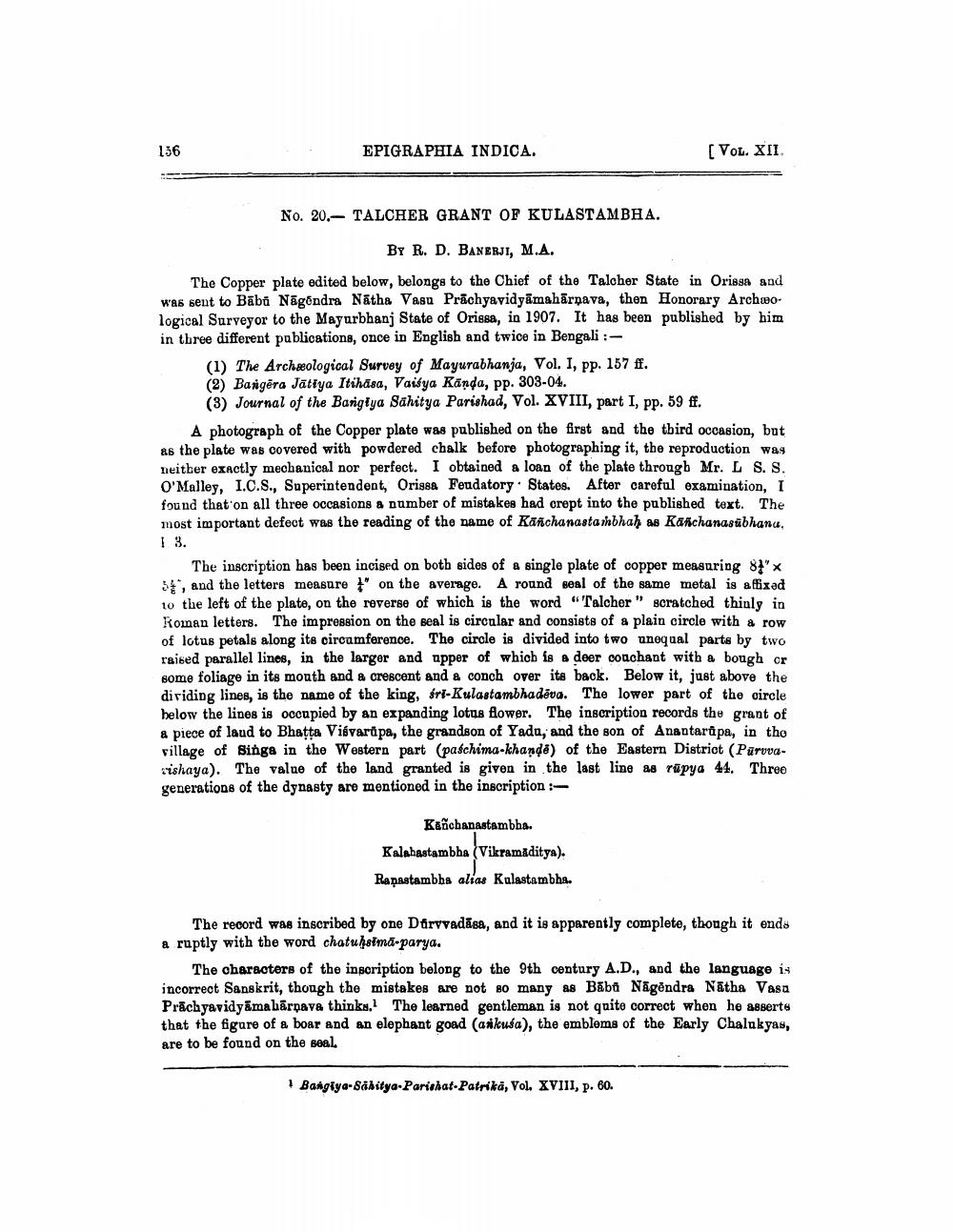________________
136
EPIGRAPHIA INDICA.
No. 20. TALCHER GRANT OF KULASTAMBHA.
BY R. D. BANERJI, M.A.
The Copper plate edited below, belongs to the Chief of the Talcher State in Orissa and was sent to Baba Nagendra Natha Vasu Prachyavidyamahārnava, then Honorary Archwological Surveyor to the Mayurbhanj State of Orissa, in 1907. It has been published by him in three different publications, once in English and twice in Bengali :
(1) The Archeological Survey of Mayurabhanja, Vol. I, pp. 157 ff. (2) Bangera Jatiya Itihasa, Vaisya Kanda, pp. 303-04.
(3) Journal of the Bangiya Sahitya Parishad, Vol. XVIII, part I, pp. 59 ff.
[VOL. XII.
A photograph of the Copper plate was published on the first and the third occasion, but as the plate was covered with powdered chalk before photographing it, the reproduction was neither exactly mechanical nor perfect. I obtained a loan of the plate through Mr. L S. S. O'Malley, I.C.S., Superintendent, Orissa Feudatory States. After careful examination, I found that on all three occasions a number of mistakes had crept into the published text. The most important defect was the reading of the name of Kanchanastambhah as Kanchanasübhana. I 3.
The inscription has been incised on both sides of a single plate of copper measuring 81"x 5, and the letters measure on the average. A round seal of the same metal is affixed to the left of the plate, on the reverse of which is the word "Talcher" scratched thinly in Roman letters. The impression on the seal is circular and consists of a plain circle with a row of lotus petals along its circumference. The circle is divided into two unequal parts by two raised parallel lines, in the larger and upper of which is a deer couchant with a bough cr some foliage in its mouth and a crescent and a conch over its back. Below it, just above the dividing lines, is the name of the king, sri-Kulastambhadeva. The lower part of the circle below the lines is occupied by an expanding lotus flower. The inscription records the grant of a piece of laud to Bhaṭṭa Visvarapa, the grandson of Yadu, and the son of Anantarapa, in the village of Singa in the Western part (paschima-khande) of the Eastern District (Purvvarishaya). The value of the land granted is given in the last line as rūpya 44. Three generations of the dynasty are mentioned in the inscription :
Kanchanastambha.
Kalabastambha (Vikramaditya).
Rapastambha alias Kulastambha.
The record was inscribed by one Dirvvadása, and it is apparently complete, though it ends a ruptly with the word chatuḥsima-parya.
The characters of the inscription belong to the 9th century A.D., and the language is incorrect Sanskrit, though the mistakes are not so many as Baba Nagendra Natha Vasu Prachyavidyamaharpava thinks. The learned gentleman is not quite correct when he asserts that the figure of a boar and an elephant goad (ankusa), the emblems of the Early Chalukyas, are to be found on the seal.
1 Bangiya-Sahitya-Parishat-Patrika, Vol. XVIII, p. 60.




